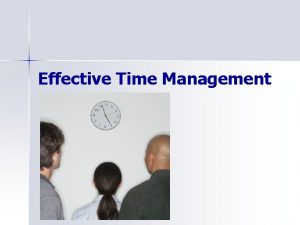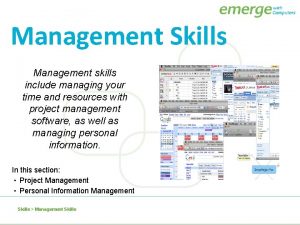Principles of Time Management Managing Your Time and





![Quadrant Analysis [I] Too many activities in Quadrant I will lead to stress, burnout, Quadrant Analysis [I] Too many activities in Quadrant I will lead to stress, burnout,](https://slidetodoc.com/presentation_image_h/d97cd1487926a31e772d1d4ab7614890/image-6.jpg)
![Quadrant Analysis [II] Too much time devoted to activities in Quadrants III and IV Quadrant Analysis [II] Too much time devoted to activities in Quadrants III and IV](https://slidetodoc.com/presentation_image_h/d97cd1487926a31e772d1d4ab7614890/image-7.jpg)


![Making an Investment in the Group: Managing Your Time Together [I] Make your workgroup Making an Investment in the Group: Managing Your Time Together [I] Make your workgroup](https://slidetodoc.com/presentation_image_h/d97cd1487926a31e772d1d4ab7614890/image-10.jpg)
![Making an Investment in the Group: Managing Your Time Together [II] Develop active listening Making an Investment in the Group: Managing Your Time Together [II] Develop active listening](https://slidetodoc.com/presentation_image_h/d97cd1487926a31e772d1d4ab7614890/image-11.jpg)
![Making an Investment in the Group: Managing Your Time Together [III] Resolve workload conflicts Making an Investment in the Group: Managing Your Time Together [III] Resolve workload conflicts](https://slidetodoc.com/presentation_image_h/d97cd1487926a31e772d1d4ab7614890/image-12.jpg)



- Slides: 15

Principles of Time Management: Managing Your Time and Your Resources Suzanne Bombard University of Virginia Library

Workshop Objectives At the end of this session, participants will be able to: Identify high and low energy periods in their day and plan their day (and time) accordingly. Identify time wasters and how to avoid them. Write a daily to-do list that prioritizes their daily tasks. Devise time management strategies for themselves and their workgroups. Devise strategies for overcoming procrastination on a personal level and as a member of a workgroup. 2

What is Time Management? “Time management is the act of controlling events. To understand time management, you must understand the nature of events around you. ” [Time Power, Charles R. Hobbs, 1988, p. 2 -3. ] In other words, time management is knowing the right first thing to do each day. Being efficient is doing things right; being effective is doing the right things well! 3

The Four Generations of Time Management First generation: notes and other written reminders. Second generation: calendars and electronic schedulers like Corporate. Time. Third generation: prioritizing; setting goals; articulating your values. “Time management and goal planning are inseparable. ” [Hobbs] Fourth generation: introspective and reflective planning; preparing for creative problem-solving in our life. 4

Time Management and the Quadrant Theory Quadrant I Urgent/Important Quadrant II Not Urgent/Important Crises; deadline-driven Preparation and prevention Quadrant III Urgent/Not Important Quadrant IV Not Urgent/Not Important Interruptions Trivia, busywork; escape activities 5
![Quadrant Analysis I Too many activities in Quadrant I will lead to stress burnout Quadrant Analysis [I] Too many activities in Quadrant I will lead to stress, burnout,](https://slidetodoc.com/presentation_image_h/d97cd1487926a31e772d1d4ab7614890/image-6.jpg)
Quadrant Analysis [I] Too many activities in Quadrant I will lead to stress, burnout, and a pattern of perpetual crisis management (putting out fires all the time). An overload in Quadrant I translates into an overload in Quadrant IV (escape). Too many activities in Quadrant III results in focusing on the short-term and feeling victimized. 6
![Quadrant Analysis II Too much time devoted to activities in Quadrants III and IV Quadrant Analysis [II] Too much time devoted to activities in Quadrants III and IV](https://slidetodoc.com/presentation_image_h/d97cd1487926a31e772d1d4ab7614890/image-7.jpg)
Quadrant Analysis [II] Too much time devoted to activities in Quadrants III and IV creates irresponsibility and may result in demotion or dismissal. More time devoted to Quadrant II activities will lead to more creativity, vision, balance, control, discipline, and a healthier perspective on life. There will also be fewer crises to contend with on a regular basis. 7

How Do We Get There From Here? Know your “circadian rhythms”: when your energy peaks and when it slumps during the course of a day. Identify your time wasters—as individuals and as a group. Develop more effective work habits by organizing your workstation(s) accordingly. Set aside fifteen minutes each day to prioritize your activities: figure out what needs to be done, as well as what doesn’t need to be done. Make this a part of routine workgroup or departmental meetings. 8

Time Management Goals – The Short List 1. 2. 3. 4. 5. 6. 7. 8. 9. 10. Evaluate present performance. Refine goals using a defined standard of excellence. Prepare a prioritized daily action list each day. Have an A priority item on your desk in the morning; divide it into smaller tasks, if needed. Do one thing at a time where thought is required. Do the most vital task now. Do the most difficult task first. Use support staff to reinforce vital priorities; delegate when necessary. Say no when a request is not vital. Clean your desk every afternoon before leaving work. [Hobbs, pp. 155 -157] 9
![Making an Investment in the Group Managing Your Time Together I Make your workgroup Making an Investment in the Group: Managing Your Time Together [I] Make your workgroup](https://slidetodoc.com/presentation_image_h/d97cd1487926a31e772d1d4ab7614890/image-10.jpg)
Making an Investment in the Group: Managing Your Time Together [I] Make your workgroup a team: spend time communicating with each other about how to work together more effectively. Address these issues at regular meetings. Don’t skimp on time spent writing goals and mission statements: these are group-defining and group-building activities. Make sure everyone has the appropriate level of training for his/her job. An investment in training at the outset will save time later on. Meet daily or weekly to discuss the objectives and priorities of the day or the week. Keep each other fully informed about what’s happening in the department. This will reduce interruptions. 10
![Making an Investment in the Group Managing Your Time Together II Develop active listening Making an Investment in the Group: Managing Your Time Together [II] Develop active listening](https://slidetodoc.com/presentation_image_h/d97cd1487926a31e772d1d4ab7614890/image-11.jpg)
Making an Investment in the Group: Managing Your Time Together [II] Develop active listening skills to avoid miscommunication. Ensure that your workgroup interacts together collaboratively by making negotiation the basis of communication. Communicate assertively, not aggressively (at their expense) or passively (at our expense). Give clear instructions that won’t generate questions later on. Time spent answering questions isn’t spent doing the job. “Fuzzy” instructions often lead to procrastination. 11
![Making an Investment in the Group Managing Your Time Together III Resolve workload conflicts Making an Investment in the Group: Managing Your Time Together [III] Resolve workload conflicts](https://slidetodoc.com/presentation_image_h/d97cd1487926a31e772d1d4ab7614890/image-12.jpg)
Making an Investment in the Group: Managing Your Time Together [III] Resolve workload conflicts that arise from competing priorities or from sharing an employee’s time with another supervisor. This should be the responsibility of the supervisor(s). Three approaches to resolving these conflicts might be to: • Enforce a first-come, first-served policy • Divide the employee’s time equally • Assign each task an A, B, or C priority. In the case of competing priorities, the supervisor(s) should decide which tasks and projects take precedence over others. This information should be communicated to 12 the employee with no equivocation.

Seven Steps to Goal Planning Prepare goals within the framework of your unifying principles. Plan your goals within the reach of your abilities, of what you realistically think you can accomplish. Write down each goal. (This is important in making the commitment!) See that a goal is your very own. Seek appropriate help. Ask yourself the important question: “Am I willing to pay the price? ” [Hobbs, p. 48] 13

It’s All in Our Mindset: The Choice is Ours I have to/I must I should I need I should have I can’t I would like to/I will I could I want I could have I won’t 14

Other Resources ¬ Breathing Space: Living and Working at a Comfortable Pace in a Sped-Up Society, Jeff Davidson, 1991, 2000. ¬ File Don’t Pile … A Proven Filing System for Personal and Professional Use, Pat Dorff, 1986. ¬ Organizing Your Work Space: A Guide to Personal Productivity, Odette Pollar, 1992, 1999. 15
 Serve as your guide in managing your enterprise
Serve as your guide in managing your enterprise Guide to managing and maintaining your pc
Guide to managing and maintaining your pc Guide to managing and maintaining your pc
Guide to managing and maintaining your pc Guide to managing and maintaining your pc
Guide to managing and maintaining your pc Give us your hungry your tired your poor
Give us your hungry your tired your poor Managing your personal finances textbook answers
Managing your personal finances textbook answers Chapter 16 managing the stress in your life
Chapter 16 managing the stress in your life Managing your online identity
Managing your online identity Managing your payables
Managing your payables Managing your weight part 2
Managing your weight part 2 Principles of project cost management
Principles of project cost management Start time end time and elapsed time
Start time end time and elapsed time Depth and breadth of brand awareness
Depth and breadth of brand awareness Managing quality in operations management
Managing quality in operations management Managing assets vs asset management
Managing assets vs asset management Managing assets vs asset management
Managing assets vs asset management





























